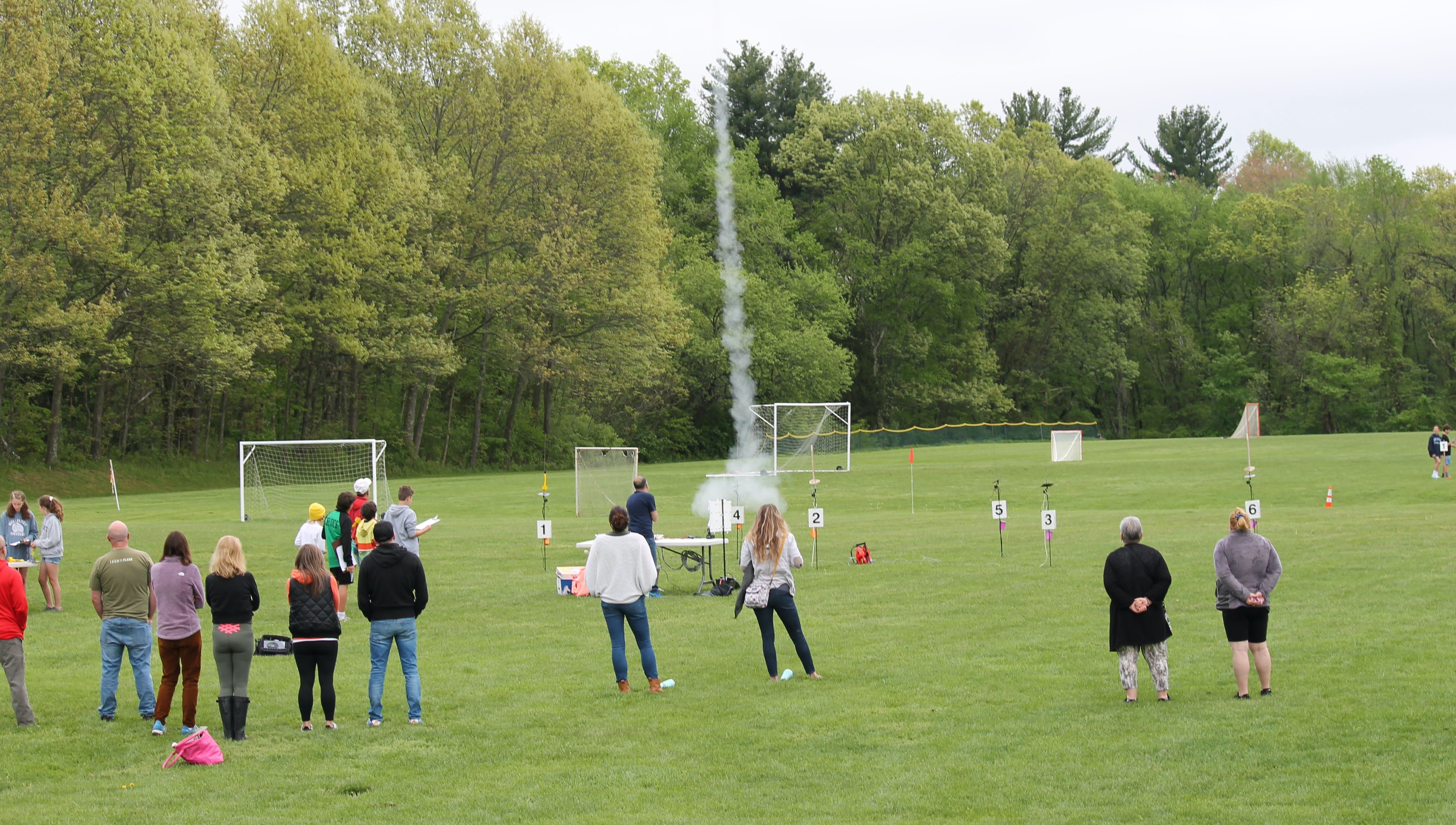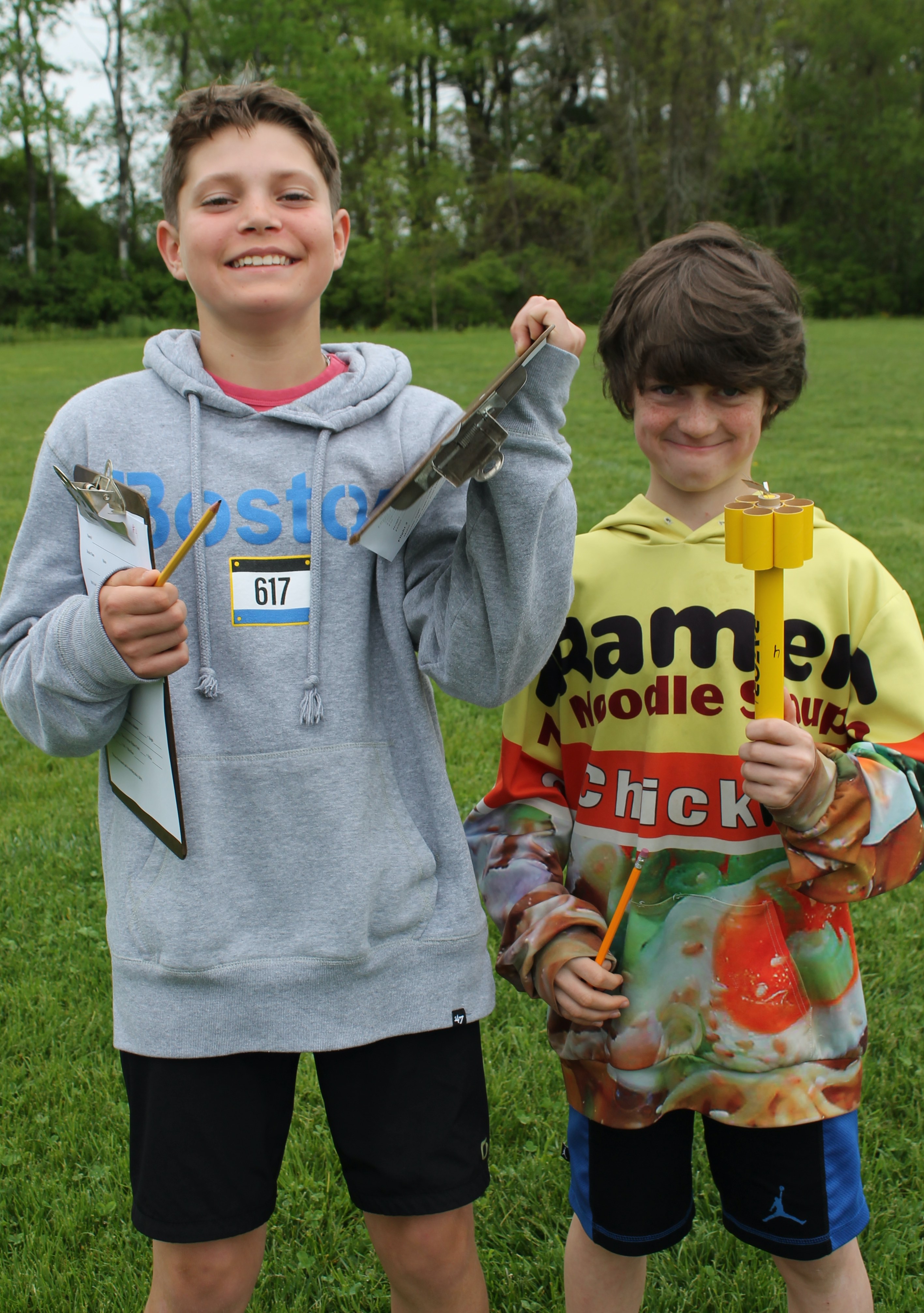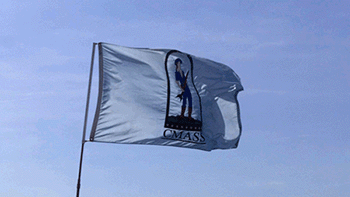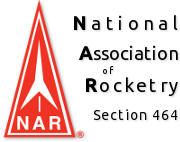 After a two-year covid hiatus, rocketry is back at the John C. Page School in West Newbury. Rocketry was sorely missed and everyone is thrilled to have it back. That's a good feeling and shows we are doing something special for the 6th graders at the Page.
After a two-year covid hiatus, rocketry is back at the John C. Page School in West Newbury. Rocketry was sorely missed and everyone is thrilled to have it back. That's a good feeling and shows we are doing something special for the 6th graders at the Page.
The class size has been trending down at the Page School over the last few years and this year was the smallest 6th grade class that we've had since  starting rocketry 14 years ago; only 35 students split into two home rooms. John Benvenuti is still there and now they have a new math/science teacher, Trina Forest. She is fully on board with rocketry and is a great addition to the team. With only two homerooms, we built two rockets: Fliskits Thing-a-ma-jig and Custom Razor. Each year there seems to be some occurrence or characterization that best describes the unit that year. In past years, it almost always involved glue - usually too much - way-too-much! But the kids have been pretty good with glue for a while now. We did have one - 'too much is not enough glue' - team this year; but everyone else was pretty good. This year the characterization would be just the excitement of having rocketry back! Pictures are in the Gallery.
starting rocketry 14 years ago; only 35 students split into two home rooms. John Benvenuti is still there and now they have a new math/science teacher, Trina Forest. She is fully on board with rocketry and is a great addition to the team. With only two homerooms, we built two rockets: Fliskits Thing-a-ma-jig and Custom Razor. Each year there seems to be some occurrence or characterization that best describes the unit that year. In past years, it almost always involved glue - usually too much - way-too-much! But the kids have been pretty good with glue for a while now. We did have one - 'too much is not enough glue' - team this year; but everyone else was pretty good. This year the characterization would be just the excitement of having rocketry back! Pictures are in the Gallery.
This year's prebuild session, where a few students stay after school and help assemble parachutes, streamers and motor packets, fill glue bottles and prep each kit for the build session, went very well. We usually have it the week before, but this year it was the day before the build, which made things a little easier. I usually bring in some of my rockets that I use to decorate the room with, on the morning of the build. This year, with the help of the students, we decorated the room during the pre-build. The kids were really good at following instructions and being efficient. It was a good omen.
As usual for the build, each homeroom as a different rocket, and we follow the same procedure during the build. I demonstrate how various parts go together - the 'dry-fit', with the kids just watching. The kids then do the same dry-fit and if all parts fit together nicely, we follow it with glue. In the middle of build session, we stop to allow the glue to set on the parts that were constructed so far, and I give a short lesson in rocketry, triangulation and some basic physics. In past years, we usually have somewhere between 60 and 90 minutes for the build session. This year we had a full two hours for each class, which made things a lot easier and there was even some time to view a few rocketry videos at the end of the build.
Launch day was postponed one day because of a forecast of showers. It didn't happen, but the rain day was a lot nicer anyway. Launch day starts with me setting up the launch field that morning. I got it down now so that I can get it all set up in 75 minutes! On the way to the field, I usually stop at the maintenance building to check with the crew that the sprinklers are not set to go on that morning (it has happened in the past!). Back in John's homeroom, we have all the students prep their rockets for their first flight, with an A8-3 motor and parachute. We go over the procedure and rules for the launch, and the teams fill out their launch card. We had 5 proctors for the launch, John as LCO, Trina helping students at the tracking station, two teacher aids helping at the reload table and general crowd control, and myself as RSO and fixing problems and answering questions as needed. We had about 20 parents attending this year.
Each team launched their rocket three times, first on an A8-3, second on a B6-4, third on either A8-3 or B6-4 (their choice). The teams use an Estes Altitrak and stopwatch to measure how high their rockets flew and average velocity at the tracking station 200 ft away from the launch pad. The rockets recover via chute on the A motor and then on a streamer for the B motor. Each year we get a big 'Wow!' from the kids and parents when we launch the first B motor. They are just amazed at how high it goes. The teachers and I love hearing it. It never gets old! We had a few rockets leave the field but were retrieved by parents; no lawn darts, no core samples, no CATO's, one damaged rocket (easily repaired with CA for its next launch) and one Razor still up in a tree.
After all of the team launches were done, I launched a few of my own: a two-stage Thing-a-ma-jig, corkscrew rocket, LOC Cool Spool (on F50-4T) and Frick-n-Frack. The spool was a big hit, mostly for the noise of the motor and the Frick-n-Frack is a perennial favorite - everyone loves it. Finally, we launched six Thing-a-ma-jigs each with two 80 ft. streamers attached to its fins - and we got all six! The kids and parents really love this. We took our group shot, cleaned up the field and the kids headed back to school. That afternoon, they finished their calculations. The writing and drawing assignment section of the unit was finished the next day.
Another rocketry unit in the books.


